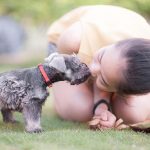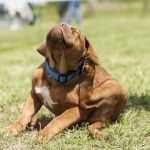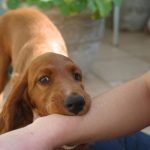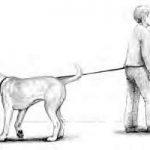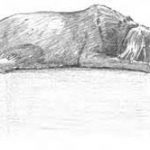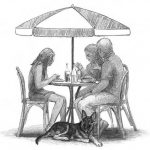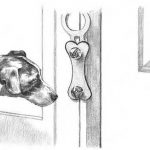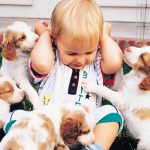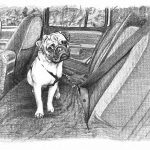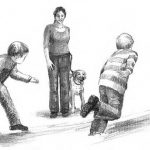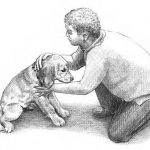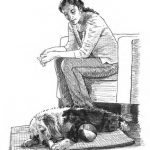Profiling the Herding Group
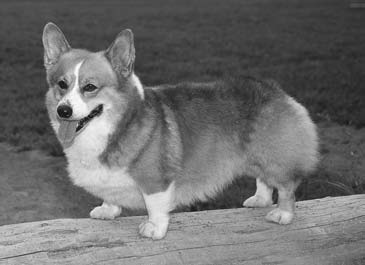

In This Chapter
- Characterizing the Herders
- Running circles around the competition
- Choosing a breed for your own flock
- Transitioning from farm to split-level
To see a Herding dog in action is to see something quite amazing.
Whether by staring, nipping, stalking, circling, or barking, Herding breeds have an incredible ability to control the movement of other animals. The work requires great endurance, with constant running and patrolling to keep herds or flocks together. These breeds are highly intelligent and able to work with a shepherd or rancher to follow commands, but they are also perfectly capable of thinking on their own when necessary.
Created in 1983, the Herding Group is the newest AKC classification, made up of breeds that were formerly members of the Working Group. Although the group is diverse, the breeds are known for their stamina and obedience, and are able to follow the signals of their master and execute them with great skill.
The job of herder should not be taken lightly; some farmers use one dog to herd more than a thousand animals at a time!
Consider the diminutive Cardigan Welsh Corgi: At about a foot tall, this remarkable dog can drive an entire herd of cows to their destination. Never losing sight of the job at hand, a Corgi runs circles around a herd, moving cows together and collecting strays that may escape from the group.
The Shetland Sheepdog, only slightly larger than the Corgi, was bred down to its current small size to better control the smaller livestock common to the rugged Shetland Islands of the British Isles. The dogs were hardy enough to endure the harsh climate and smart enough to even be left in charge of the animals when the farmers weren’t around.
Today most Herding dogs live as household pets, with little or no contact with farm animals. With or without livestock, these dogs are still instinctual herders and will herd whoever and whatever they can, including other dogs and children.
Herding breeds need socialization and close contact with humans, and they should have access to both home and yard.
Members of the Herding Group are described as follows:
- Loyal
- Energetic
- Smart
- Territorial
- Inclined to chase
Herding dogs are happiest when they have a job to do. People who live with herders find that exercise, training, and activities such as agility, and obedience activities and training provide an outlet for all the energy they possess.
Because they are alert and protective, Herding breeds are capable watchdogs in the home. Some, such as the German Shepherd and Malinois, are excellent police and military dogs and are used in search-and-rescue efforts.
Australian Cattle Dog
History/Evolution: The Australian Cattle Dog was developed in Australia in the 1800s when it became clear that European herding dogs could not withstand the country’s rough terrain and climate. Australian cattlemen needed a dog who could herd a wilder type of cattle; crosses may have included Dingos, Highland Collies, Black and Tan Kelpie, and the Dalmatian. Though the breed was slow to catch on in the U.S., it has proved an untiring and effective herder. The AKC recognized the breed in 1993.
Size: Medium, 35 to 45 pounds; females 17 to 19 inches; males 18 to 20 inches.
Color: Blue or red (mottled or speckled), with or without black, blue, or tan markings.
Temperament: Intelligent, independent, tenacious, energetic, hardy, and untiring. Loyal and protective; suspicious of strangers. Needs a job. Herds children, sometime with nips.
Energy level: High.
Best Owner: Active owners with time and energy for hard, daily exercise; a family with older children and a fenced yard.
Needs: A lot of physical and mental activities (more than a walk — think agility course and obedience lessons), opportunities to herd, regular brushing.
Life expectancy: 10 to 13 years.
Photograph © Jean Fogle
Australian Shepherd
History/Evolution: Despite its name, the Australian Shepherd probably originated in the Pyrenees Mountains between Spain and France; the name comes from association with shepherds who came from Australia to the western U.S. in the 1800s. Ranchers continued to develop the breed to its current high level of versatility, intelligence, and trainability. Appearances in movies, television shows, and rodeos helped boost popularity. The breed excels as guide, hearing, therapy, and search-and-rescue dogs.
Size: Medium; females 18 to 21 inches, 40 to 55 pounds; males 20 to 23 inches, 50 to 65 pounds.
Color: Blue merle, red (liver) merle, and black or red, all with or without copper and/or tan markings.
Temperament: Bold, alert, confident, independent, and smart; difficult if lacking a challenge. May try to herd children and small animals by nips.
Energy level: Medium to high.
Best Owner: Active owner in a rural or suburban home.
Needs: Daily workouts with mental and physical challenges (agility, flyball, obedience, tracking, freestyle), fenced yard, weekly brushing, companionship.
Life expectancy: 12 to 14 years.
Photograph © Jean Fogle
Bearded Collie
History/Evolution: Developed in Scotland, the Bearded Collie may trace its ancestors to the Komondor, British Isles herding dogs, and the Poland Lowland Sheepdog. In Scotland, the energetic Beardies were tireless sheepherders and later gained popularity as show dogs. The AKC recognized the breed in 1977. The Bearded Collie has loads of fans who enjoy the breed as a companion who likes plenty of activity, whether in the form of agility, Frisbee, or herding a backyard full of children.
Size: Medium; females 20 to 21 inches, 40 to 45 pounds; males 21 to 22 inches, 50 to 60 pounds.
Color: Black, brown, blue, or fawn, usually with white markings.
Temperament: Lively, playful, and enthusiastic; devoted, intelligent, and self-confident. Exuberant with kids; may try to herd young children while playing.
Energy level: Medium to high.
Best Owner: Active owner or family with post-toddler children.
Needs: Family bonding, vigorous daily exercise, fenced yard, weekly brushing and combing sessions.
Life expectancy: 12 to 14 years.
Photograph © Jean Fogle
Beauceron
History/Evolution: The Beauceron is a French herding dog dating back to the 1500s, highly valued as a farm dog, drover, and guardian of sheep and family. In 1863, the breed was differentiated into long-coated (Briard) and short-coated (Beauceron). During World War I and II, the military used them as messenger dogs and mine detectors. Although the breed has been relatively unknown outside of France, the Beauceron has recently begun to gain the attention of fanciers in the U.S. and elsewhere.
Size: Medium to large, 65 to 85 pounds; females 24 to 261⁄2 inches; males 251⁄2 to 271⁄2 inches.
Color: Black and tan, or black, gray, and tan.
Temperament: Self-assured, courageous, calm, and intelligent. Loyal and devoted to family, but without training, can take over. Very protective; may herd children.
Energy level: Medium to high.
Best Owner: Active owner or family with fenced yard.
Needs: Daily mental and physical exercise, firm obedience training, some time outdoors, human contact.
Life expectancy: 10 to 12 years.
Photograph © Jean Fogle
Belgian Malinois
History/Evolution: The Belgian Malinois shares a foundation with other Belgian sheepherding breeds, including the Belgian Sheepdog and the Belgian Tervuren — Belgian dogs share a breed standard in all countries except the U.S. Developed in the city of Malines, Malinois is prized as a confident herder and guard. Although it has experienced uneven growth in popularity outside Belgium, the Malinois is considered a preeminent security and police dog, ranking even above the German Shepherd.
Size: Medium to large; females 22 to 24 inches, 50 to 60 pounds; males 24 to 26 inches, 55 to 75 pounds.
Color: Fawn to mahogany, with black mask and ears.
Temperament: Confident, intense, alert; protective without being overly aggressive. Happiest with plenty of activity and a job; quick and responsive to commands.
Energy level: High.
Best Owner: Active, confident owner with experience handling dogs and time for training and socialization.
Needs: A lot of exercise (not leashed strolls) and mental stimulation (obedience training and tracking), fenced yard, weekly brushing.
Life expectancy: 10 to 12 years.
Photograph © Isabelle Francaise
Belgian Sheepdog
History/Evolution: Known as the Groenendael, or Chien de Berger Beige in most parts of the world, the Belgian Sheepdog traces its origins to the late 1800s. Like all Belgian shepherds, the breed was an accomplished herder and guard. In the early 1900s Belgian Sheepdogs were gaining a reputation as police dogs. During World War I and II, they served as sentry dogs, message carriers, and ambulance dogs. Today they continue to serve society well, as guide and therapy dogs and as devoted companions.
Size: Medium to large; females 22 to 24 inches, 40 to 60 pounds; males 25 to 26 inches, 50 to 75 pounds.
Color: Black.
Temperament: Watchful, attentive, courageous, and intense; possessive and aggressive toward dogs and animals. Intelligent but independent. Aloof with strangers.
Energy level: High.
Best Owner: Patient but firm owner with time for training and socialization.
Needs: Tolerance with shedding and weekly brushing, fenced yard, cool climate, plenty of mental and physical stimulation (herding trials).
Life expectancy: 10 to 12 years.
Photograph © Isabelle Francaise
Belgian Tervuren
History/Evolution: One of the four Belgian shepherd breeds, the Belgian Tervuren’s protective instincts and herding abilities made it an ideal dog for rural farmers in Belgium. The dogs continued as beloved companions even after machines gradually took over the breed’s farm duties. A drop in numbers nearly caused the Belgian Tervuren to disappear by 1930, but fanciers have rescued the breed to its current moderate popularity.
Size: Medium to large; females 22 to 24 inches, 45 to 60 pounds; males 24 to 26 inches, 65 to 80 pounds.
Color: Fawn to mahogany, with black overlay.
Temperament: Alert and energetic; affectionate and possessive with family, but observant and aloof with strangers. Given exercise and challenges, can be well-mannered companion. May nip at children’s heels.
Energy level: High.
Best Owner: Active, confident owner who has time for training.
Needs: Strenuous daily activity (jogging, serious play or working session) and mental challenges of obedience, agility, tracking; regular brushing and interaction; fenced yard.
Life expectancy: 10 to 14 years.
Photograph © Jean Fogle
Border Collie
History/Evolution: The Border Collie is the consummate sheepdog. The energetic breed’s origins can be traced back to the 1800s, in the border country between Scotland and England. One accomplished individual, named Hemp, is considered the father of the breed; his herding skills were considerable, especially his intimidating stare. Although many of the breed’s devotees wanted to keep the Border Collie out of the show ring, the AKC recognized it in 1995. Studies suggest that the Border Collie may be the most intelligent dog.
Size: Medium; 18 to 20 inches, 30 to 45 pounds.
Color: Black, blue, chocolate, and red, with or without white markings or merling.
Temperament: Energetic, intelligent, and an intense worker who can be destructive if not sufficiently challenged. Loves to chase (not the best choice for families with children).
Energy level: High.
Best Owner: Active owners with time for exercise or someone who lives on a farm.
Needs: Daily exercise, a job, obedience training, fenced yard, regular brushing.
Life expectancy: 12 to 14 years.
Photograph © Jean Fogle
Bouvier des Flandres
History/Evolution: Bouvier means “cowherd” in French, and that’s exactly what the Bouvier des Flandres did best. Because early individuals of the breed were strictly working dogs, the dogs came in a variety of sizes and colors. Interest in the breed developed in the early 1900s, and an accepted standard soon followed. Although the Bouvier des Flandres is not extremely popular, it is recognized for its excellence in dog shows and herding trials.
Size: Large; females 231⁄2 to 261⁄2 inches, males 241⁄2 to 271⁄2 inches, 60 to 90 pounds.
Color: Fawn to black, salt and pepper, gray, and brindle.
Temperament: Steady, resolute, and fearless. Loyal, devoted, and protective; reserved with strangers and can be aggressive with strange dogs. Independent and confident, but willing to please.
Energy level: Medium to high.
Best Owner: Strong, confident owner with time for training, exercise, and grooming.
Needs: Daily interaction and exercise (herding is ideal, but running and playing work), fenced yard, cool climate, early training, and regular brushing and grooming.
Life expectancy: 10 to 12 years.
Photograph © Jean Fogle
Briard
History/Evolution: Records of the Briard, the oldest of the four French sheepdog breeds, date back to the 1300s. Though the Briard originally defended estates and flocks against wolves and human intruders, its role developed into more of a peaceful herder. The tale goes that the breed surfaced in the U.S. with either the Marquis de Lafayette or Thomas Jefferson. In 1922 the AKC registered the first litter of Briards. The breed is still a popular sheepherder in France.
Size: Large; females 22 to 251⁄2 inches, 50 to 65 pounds; males 23 to 27 inches, 75 to 100 pounds.
Color: Black, gray, and tawny.
Temperament: Naturally protective, fearless, reserved with strangers; loyal, loving, gentle with friends and family. Intelligent and independent, easily trained. May try to herd children.
Energy level: Medium.
Best Owner: Firm, confident owner.
Needs: Daily exercise (long walk or jog, play session) and interaction (training), early training and socialization, frequent brushing to prevent matting.
Life expectancy: 10 to 12 years.
Photograph © Isabelle Francaise
Canaan Dog
History/Evolution: The Canaan Dog has a long and eventful history, beginning in ancient times in the biblical Land of Canaan as an adept guard and herd dog of the ancient Israelites; when the Israelites were dispersed by the Romans 2,000 years ago, many dogs survived on their own or lived with Bedouins, who raised them as guard and livestock dogs. Later, Canaan Dogs were trained as sentry dogs, messengers, and land mine locators. The first Canaan Dogs arrived in the U.S. in 1965.
Size: Medium; females 19 to 23 inches, 35 to 45 pounds; males 20 to 24 inches, 45 to 55 pounds.
Color: White with black, brown, or red markings; brown or black, with or without white markings.
Temperament: Devoted, docile, and willing to please family; reserved and aloof with strangers. Alert, vigilant, and territorial; vocal and persistent.
Energy level: Medium.
Best Owner: Active owner in a suburban or rural home.
Needs: Plenty of exercise and mental and physical challenges; secure fencing, training, human contact, weekly brushing, and early socialization.
Life expectancy: 12 to 15 years.
Photograph © Sarah O’Neill
Collie (rough and smooth)
History/Evolution: Long used as herding dogs in Scotland and England, the Collie became fashionable after Queen Victoria was smitten with the breed in 1860. Two varieties of Collie exist: rough coated and smooth, the smooth and rough varieties are identical in standard except for their coats. Settlers brought Collies to the U.S. to work sheep farms, and the breed continued its rise in popularity. Lassie, the most famous rough-coated Collie of all time, further solidified the breed’s place in popular history.
Size: Medium to large; females 22 to 24 inches, 50 to 65 pounds; males 24 to 26 inches, 60 to 75 pounds.
Color: Sable and white, tricolor, blue merle, and white.
Temperament: Sensitive, intelligent, gentle, and mild mannered. A devoted family dog; especially good with children, but may nip at heels. Some bark when left alone.
Energy level: Medium.
Best Owner: Active family.
Needs: Daily exercise (herding is an excellent choice), close bonding with family, gentle handling, weekly brushing.
Life expectancy: 10 to 13 years.
Photograph © Jean Fogle
German Shepherd Dog
History/Evolution: The product of much development, the German Shepherd Dog is the result of breeder efforts to produce the ideal herder and guarder of flocks. The German Shepherd possesses it all: strength, dependability, intelligence, and courage. Off the farm, the breed was quick to prove itself a capable police and war dog, and later as a guide, search-and-rescue dog, and show dog. Thanks to movie stars such as Strongheart and Rin Tin Tin, the breed’s popularity soared in the 1920s and 1930s.
Size: Large; females 22 to 24 inches, 60 to 70 pounds; males 24 to 26 inches, 75 to 95 pounds.
Color: All colors except white; typically black and tan, sable, and black.
Temperament: Direct, fearless, and protective but not hostile; suspicious of strangers. A poised, intelligent guardian. Devoted to family; dogs from well-bred lines are great with children.
Energy level: Medium.
Best Owner: Active, confident owner or family.
Needs: Daily mental and physical challenges (exercise, play sessions, and learning), fenced yard, obedience, close human contact, lots of brushing (heavy shedder).
Life expectancy: 10 to 12 years.
Photograph © Jean Fogle
Old English Sheepdog
History/Evolution: A relatively new breed, the Old English Sheepdog originated in the 1800s in the west of England, probably a descendant of the Scotch Bearded Collie and the Russian Owtchar. The dogs drove sheep and cattle to market, and were known as “Bobtail” because of their docked tails (a sign that they were working dogs and exempt from taxes). The dog’s coat insulates it from cold, heat, and dampness. Though the profuse coat can be a deterrent, the Old English Sheepdog is an ideal house dog.
Size: Large; females 21 inches and up, 60 to 80 pounds; males 22 inches and up, 70 to 90 pounds.
Color: Gray, grizzle, blue, or blue merle, with or without white.
Temperament: Energetic, adaptable, intelligent, gentle, and clownish. Devoted, thrives on companionship; protective of family members and will herd children. Can be headstrong or bossy.
Energy level: Medium.
Best Owner: Active, confident owner; families, if someone has time for grooming.
Needs: Daily exercise (consider herding), fenced yard, human contact, serious brushing every other day to prevent matting.
Life expectancy: 10 to 13 years.
Photograph © Jean Fogle
Norwegian Buhund
History/Evolution: The Norwegian Buhund traces its history to the Vikings, with whom they traveled by sea and land; remains of the earliest Buhunds were found in a Viking grave from about the year 900. The modern Norwegian Buhund resembles the refined Buhunds of Norway, which guarded farms and herded sheep. Today’s Buhund still works with livestock and guards home and family — and is happy lying at an owner’s feet at the end of the day. The AKC recognized the breed in January 2009.
Size: Medium; females 16 to 171⁄2 inches, 26 to 35 pounds; males 17 to 181⁄2 inches, 31 to 40 pounds.
Color: Wheaten, with or without black mask; black.
Temperament: Energetic, lively, with great stamina; quick learners. Alert, self-confident, and independent, but affectionate with people.
Energy level: High.
Best Owner: Active, firm owner or family in a suburban or rural home.
Needs: Daily exercise and lots of playtime (running/walking, herding, Frisbee, agility), firm obedience training, fenced yard, and family contact.
Life expectancy: 13 to 15 years.
Photograph © Isabelle Francaise
Polish Lowland Sheepdog
History/Evolution: Known to much of the world as the Polish Owczarek Nizinny, the Polish Lowland Sheepdog goes by the nickname PON. The breed’s origins go back to the early history of Poland, with crossings that may include Tibetan Terrier and Puli. Because the PONs were smaller than some of the larger flock-guarding dogs, they didn’t scare the sheep as much and had better endurance. The PON survived World War I and remains a valued sheepherder and companion; its size makes it suitable to apartment life.
Size: Medium, 30 to 50 pounds; females 17 to 19 inches; males 18 to 20 inches.
Color: Any color.
Temperament: Self-confident, independent, willful; more serious than its appearance. Affectionate, but territorial and wary with strangers. Barks often. Good with children, especially when raised with them.
Energy level: Medium to high.
Best Owner: Active, firm, and consistent owners.
Needs: Daily exercise for mind and body (herding and agility are ideal), fenced yard, firm training, socialization, considerable brushing and combing of coat.
Life expectancy: 12 to 14 years.
Photograph © Isabelle Francaise
Puli
History/Evolution: Some believe that Tibetan Terriers and sheepdogs of France and Germany played a role in this breed’s development in Hungary in the Middle Ages. The Puli’s small size, speed, and agility made it an excellent sheepherder; the unusual corded coat is the breed’s natural protector. Crossbreeding nearly led to the Puli’s extinction, but Puli devotees worked to reconstitute the breed in the early 1900s. Today the Puli is more a trusted watchdog and companion than sheepherder.
Size: Medium, 30 to 35 pounds; females 16 inches; males 17 inches.
Color: Rusty black, black, gray, and white.
Temperament: Energetic, curious, and smart. Protective of family, suspicious, and watchful; barks and can be aggressive toward other dogs. Home loving and affectionate.
Energy level: High.
Best Owner: Active owner who can handle firm and fair training.
Needs: Daily exercise, a job to do (herding children or sheep), serious coat care (cording and cleaning), training.
Life expectancy: 12 to 16 years.
Photograph © Isabelle Francaise
Pyrenean Shepherd
History/Evolution: Remains of ancient sheepherding dogs have been found in the Pyrenees Mountains of Southern France, and many Pyrenean Shepherds still herd in those mountains, but exact origins remain unclear. The dogs are relatively small, and so are quicker and require less food than larger sheepherder dogs. Two varieties exist: Rough-Faced and Smooth-Faced. First brought to the U.S. in the 19th century, the breed earned AKC recognition in the Herding Group in January 2009.
Size: Medium; between 15 and 21 inches, 15 to 30 pounds.
Color: Fawn or fawn with a black overlay, brindle, and gray; solid black and blue merle.
Temperament: Energetic and active, dominated by a love of work. Devoted and affectionate with immediate family, but distrustful of strangers. Strong barking instinct.
Energy level: High.
Best Owner: Active owner able to devote time to training.
Needs: Daily exercise, fenced yard, inclusion in owner’s/family’s activities, training, early socialization, regular brushing.
Life expectancy: 12 to 15 years.
Photograph © Isabelle Francaise
Shetland Sheepdog
History/Evolution: The Shetland Sheepdog’s history goes back to the Border Collie, which was brought to the Scotland’s Shetland Islands and crossed with other breeds to develop the Sheltie. The miniature Shetland proved itself to be a hard worker, protecting home, flock, and herd — and found its way into the hearts (and homes) of farm families. The breed earned it AKC recognition in 1911 and has continued to excel as a dedicated worker, loyal companion, and able competitor in obedience, herding, and agility trials.
Size: Small to medium; 13 to 16 inches.
Color: Black, blue merle, and sable, with white and sometimes tan marking.
Temperament: Loyal, affectionate, and obedient; devoted to family and excellent with children. Intelligent and highly trainable. Reserved toward strangers and barks a lot.
Energy level: Medium to high.
Best Owner: Family or active owner who has time for keeping company with a dog.
Needs: Daily exercise and activity (agility, herding, conformation), lots of family contact, early socialization, brushing every other day.
Life expectancy: 12 to 14-plus years.
Photograph © Jean Fogle
Swedish Vallhund
History/Evolution: The Swedish Vallhund is an ancient breed with origins that go back to the Vikings, when it was known as the Vikingarnas Hund, or “Viking Dog.” A small, powerful, sturdy breed, the Swedish Vallhund excels as cattle drover, watchdog, ratter, and general farmhand. Although the Corgi and the SV share some similarities, the SV is longer legged and not as stocky. The dog faced extinction in Sweden in 1942 but was rescued by a devoted fan. The AKC recognized the breed in 2005.
Size: Small to medium; 12 to 16 inches, 25 to 35 pounds.
Color: Gray through red and combinations of these colors in various shades.
Temperament: Alert, fearless, intelligent. Responsive, devoted, and affectionate; loves attention and craves leadership. Can be overprotective if not trained and socialized; may bark a lot.
Energy level: Medium.
Best Owner: Active owner with yard or time for daily walks.
Needs: Daily exercise, early socialization and training, regular brushing.
Life expectancy: 12 to 14 years.
Photograph © Jean Fogle
Cardigan Welsh Corgi
History/Evolution: The older of the two Corgi breeds, the Cardigan Welsh Corgi was brought to Cardiganshire (South Wales) from Central Europe by the Celts around 1200 BC. Later the Corgis served their masters well by driving cattle from the farmers’ meager acreage out to the common land owned by the Crown. Although the breed became less useful when the land was sold off and fenced in, it has survived, with the Cardigan and the Pembroke officially divided into two types in 1934.
Size: Small to medium, 101⁄2 to 121⁄2 inches; females 25 to 35 pounds; males 30 to 45 pounds.
Color: All shades of red, sable, and brindle; also blue merle or black, both with or without tan or brindle points; white markings common.
Temperament: Loyal, affectionate, and even tempered; devoted to family, but reserved with strangers. Fun and high spirited, with a love of antics and tricks. Barks.
Energy level: Medium.
Best Owner: Active owner with time for exercise.
Needs: Daily exercise (walk, herding, or play session), fenced yard, regular brushing.
Life expectancy: 12 to 14 years.
Photograph © Jean Fogle
Pembroke Welsh Corgi
History/Evolution: The Pembroke Welsh Corgi’s history goes back to Pembrokeshire in South Wales, where it was brought over by Flemish weavers around 1100. Though it shares some obvious similarities with the Cardigan Corgi, the Pembroke has a shorter body than the Cardigan; pointed, erect ears, compared to the Cardigan’s rounded ears; and a shorter tail than the Cardigan’s. Like the Cardigan, the Pembroke is a high-spirited, amiable herder that makes a fine farmhand, competitor, and home companion.
Size: Small; 10 to 12 inches, 25 to 30 pounds.
Color: Red, sable, fawn, black and tan; with or without white markings.
Temperament: Bold, active (more easily excited than the Cardigan Corgi), and quick witted. Devoted, amiable, and willing to please. Alert; reserved with strangers. Barks. May nip at heels.
Energy level: Medium.
Best Owner: Active owner or family.
Needs: Daily physical and mental exercise (herding sessions are ideal, but walks or off-leash training sessions work), weekly brushing, human companionship.
Life expectancy: 12 to 14 years.
Photograph © Jean Fogle
by Eve Adamson, Richard G. Beauchamp, Margaret H. Bonham, Stanley Coren, Miriam Fields-Babineau, Sarah Hodgson, Connie Isbell, Susan McCullough, Gina Spadafori, Jack and Wendy Volhard, Chris Walkowicz, M. Christine Zink, DVM, PhD
























